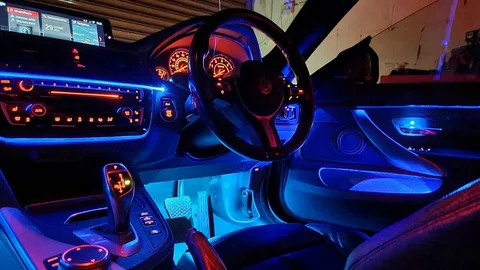The automotive interior ambient lighting system market is projected to grow from USD 42,164.3 million in 2025 to USD 79,148.3 million by 2035, expanding at a CAGR of 6.5% over the forecast period. The high demand of consumers for the luxuries of the premium cabin aesthetic, the improvement of in-vehicle comfort, and the convenience of having a personalized user experience are the factors leading to the widespread introduction of advanced ambient lighting and other related technologies in various types of vehicles.
In an era where vehicles are becoming extensions of our digital lifestyles, the cabin is no longer just a functional space—it’s a personalized sanctuary. At the heart of this transformation lies the rise of automotive interior ambient lighting systems, which have emerged as a subtle yet powerful innovation redefining how drivers and passengers experience comfort, safety, and emotion on the road.
What once served as mere footwell or dashboard illumination has now evolved into an intelligent, multi-zone lighting ecosystem that enhances driving ambiance, supports vehicle branding, and even promotes emotional well-being.
Get Ahead with Our Report: Request Your Sample Now!
https://www.futuremarketinsights.com/reports/sample/rep-gb-1503
From Utility to Emotion: Lighting as a Design Language
Modern ambient lighting systems are engineered not just for visibility, but for mood. Offering a spectrum of colors, customizable brightness levels, and dynamic light animations, these systems elevate interior aesthetics while reinforcing brand identity.
Designers and automakers use lighting to shape the cabin’s emotional tone—instilling calm with cool hues, energizing with warm tones, or signaling key driving events with pulsating effects. By engaging the senses, ambient lighting plays a vital role in the multisensory experience of driving.
Smart, Connected, and Adaptive
Today’s ambient lighting is more than decorative—it’s deeply integrated with vehicle electronics and user interfaces. Advanced systems respond to real-time data inputs like speed, climate control settings, or drive modes. Shift into “Sport” mode, and lighting might turn red; switch to “Comfort,” and it glows blue.
Integration with voice assistants and infotainment platforms allows users to adjust lighting through natural language or touchscreen interfaces, creating seamless personalization. Additionally, ambient lighting now supports biometric recognition, automatically adjusting based on the preferences of individual drivers.
Enhancing Safety and Functional Awareness
Beyond aesthetics, ambient lighting contributes to driver and passenger safety. It illuminates key touchpoints such as door handles, footwells, and cup holders—reducing distraction and improving ergonomics. More importantly, it can be used to convey alerts and warnings: red pulses can indicate open doors, while subtle glows may accompany lane-change notifications or blind spot alerts.
Night driving comfort is also significantly improved, as low-level illumination reduces eye strain and maintains focus without causing glare or distraction.
Wellness on Wheels: Lighting That Soothes
As vehicles evolve into wellness spaces, ambient lighting supports relaxation and stress reduction during transit. Some systems now include wellness-oriented modes that simulate circadian-friendly lighting patterns, helping align with users’ biological rhythms—especially important during long commutes or night drives.
Combined with massage seats, climate control, and acoustic design, ambient lighting contributes to creating a tranquil mobile environment that feels more like a luxury lounge than a machine.
Applications Across Segments and Styles
What began in luxury sedans has now trickled down to mid-range and compact vehicles, with customizable ambient lighting becoming a selling point across segments. Whether in electric vehicles, SUVs, or performance models, automakers are embracing lighting as a defining design and experiential feature.
For fleet and ride-sharing vehicles, ambient lighting offers additional value—helping distinguish brands and offering passengers a more premium and personalized travel experience.
Challenges in Customization, Cost, and Compliance
Despite growing adoption, the market still faces hurdles. Achieving true color uniformity across surfaces and components can be difficult, especially in diverse materials and lighting conditions. Keeping systems cost-effective while delivering a premium feel is another challenge—particularly in budget-conscious segments.
Regulatory compliance also plays a role, as certain lighting colors and intensities may be restricted in specific markets to prevent driver distraction or mimicry of emergency vehicles.
Exhaustive Market Report: A Complete Study
https://www.futuremarketinsights.com/reports/automotive-interior-ambient-lighting-systems-market
Lighting the Path to the Software-Defined Car
Ambient lighting systems are increasingly becoming software-defined—receiving updates over-the-air and offering downloadable themes or seasonal modes. This shift opens the door to subscription-based features, user-generated themes, and deeper integration with other in-vehicle technologies like augmented reality displays or advanced driver assistance systems (ADAS).
In the context of electric and autonomous vehicles, ambient lighting will serve as both a communication tool and a design hallmark, enhancing the interaction between occupants and smart mobility platforms.
A Future Glowing with Possibility
As vehicles become more intelligent and user-centric, interior ambient lighting systems will continue to evolve—merging technology, design, and emotion. Future innovations may include reactive lighting that syncs with music, gestures, or biometric signals, as well as advanced fiber optics and holographic projections.
Ultimately, automotive ambient lighting is more than a feature—it’s a canvas for storytelling, brand expression, and emotional connection. By blending aesthetics with intelligence, these systems are turning every ride into a curated sensory journey—one that begins not with the turn of a key, but with the soft glow of a personalized light.


